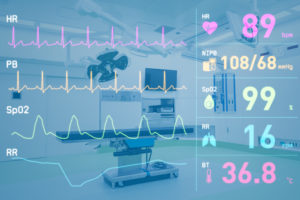 Vesela Kovacheva, MD, PhD, was not thinking about her work as an obstetric anesthesiologist when she opened an article about artificial intelligence (AI) in 2017, expecting to learn about self-driving cars and the algorithms behind online shopping.
Vesela Kovacheva, MD, PhD, was not thinking about her work as an obstetric anesthesiologist when she opened an article about artificial intelligence (AI) in 2017, expecting to learn about self-driving cars and the algorithms behind online shopping.
But as she read about AI’s potential to predict human behavior, her thoughts turned quickly to the labor and delivery suite: “This could make a huge difference in something I do every day,” she thought. “And patients could have a much better experience going through their Cesarean section and the entire birth experience.”
Kovacheva has since launched work on a machine learning algorithm to address a dominant challenge of an anesthesiologist’s work during C-section: maintaining patients’ blood pressure. When the spinal anesthetic causes blood pressure to drop, as it does in nearly 75% of patients, a vasopressor is needed to counteract this effect. The ongoing push and pull between the two requires minute-by-minute mental calculations by the anesthesiologist and frequent manual adjustment of the vasopressor infusion pump.
“We’re doing all of these things simultaneously while taking care of an anxious, awake patient and preparing for major abdominal surgery. In a couple of minutes, the math becomes too complex for any human to do, and we may under- or over treat the patient,” Kovacheva said.
Maternal consequences may include nausea, lightheadedness and infrequently stroke, which all prolong recovery. The baby may develop acidosis, hypoxia and have low Apgar scores that can lead to neonatal intensive care unit (NICU) admission and possibly poor developmental outcome.
Harnessing the Power of Machine Learning to Automate Drug Infusions
For this well-characterized and well-studied clinical response to anesthesia in childbirth, Kovacheva envisioned how machine learning could drive an anesthesia automation system. “The intended outcome of this initiative is ultimately patient safety,” Kovacheva said.
Clinical guidelines provide a starting point for vasopressor dosage for specific clinical situations, but patients often require an individualized approach. Even patients who share similar traits may react differently to the same dosage, Kovacheva explained. Arriving at the right level is sometimes a matter of trial and error.
The technology Kovacheva and colleagues are developing would analyze a patient’s real-time blood pressure, heart rate, past trends, pharmacokinetics and other data and compare that against a large database of similar scenarios. In turn, the software would recognize when vasopressor adjustment was needed. The ultimate goal is to connect the anesthesia automation system to an infusion pump that would deliver the recommended dosage directly to the patient.
From Concept to Testing an AI Algorithm
For Dr. Kovacheva, a love of math, commitment to women’s health and desire to improve the obstetrical experience all came together in this initiative. After medical school, she earned a PhD in neuroscience and researched how nutrition in pregnancy affects brain development. During her subsequent residency at Brigham and Women’s Hospital, she “fell in love with obstetric anesthesiology,” she said, including its potential for continued involvement with women’s health.
But working in AI was new for her. “I talked to as many people as I could throughout the hospital,” she said, including those with experience in machine learning. She also sought out Brigham entities designed to foster innovation. “We are very lucky to have many systems in place here at the Brigham that can actually help move a translational project,” she said.
In spring 2019, Kovacheva’s proposal for the anesthesia automation system was chosen as a finalist in the hospital’s biannual Shark Tank-style even. After each finalist presented a five-minute project pitch, followed by questions from a panel of experts and industry leaders, Kovacheva was chosen as a winner. The monetary prize, along with receipt of a second innovation grant, has helped her to continue developing the algorithm.
Collaboration of Data Scientists and Clinicians to Improve Patient Safety
Key to the effort is collaboration between data scientists and clinicians, Kovacheva said. She meets regularly with members of the hospital-supported Center for Clinical Data Science, whom she has invited into the operating room to observe specifics of the clinical challenge that the project addresses.
“This joint effort of physicians and data scientists is so important,” she said. “Generating the algorithms requires understanding the decisions that are supported by clinical evidence. The more they learn medicine and the more I learn AI, the more likely it is for us to achieve something that has real value.”
Work with obstetric nurses and physicians in the Department of Obstetrics and Gynecology also has helped move innovation forward. “The opportunity to improve patients’ experience and to increase maternal safety is a huge priority for all specialties involved: nurses, anesthesiologists and obstetricians,” she said. “We work here in that very collaborative team. We round together, and we have a preoperative huddle before every C-section.”
If successful, Kovacheva anticipates that the anesthesia automation system could be utilized for any patient undergoing C-section with spinal anesthesia. It could be useful in areas where anesthesiologists may be in short supply, as well as in other surgeries and procedures. She also envisions expanding the concept to medications such as propofol in the operating room or insulin in the intensive care unit.
Kovacheva sees AI’s potential not to replace physicians or fully automate medicine, but as a tool to improve care while also enhancing the doctor-patient relationship.
“I hope that this algorithm will actually bring us closer to the patient,” she said. “It will allow us to delegate mundane tasks to the machine so that my attention is directed to the patient and answering patient’s needs.”